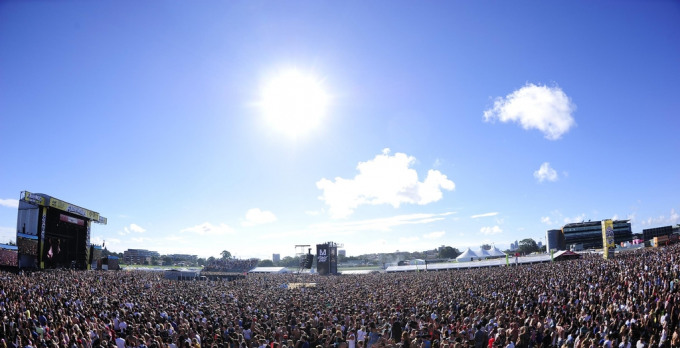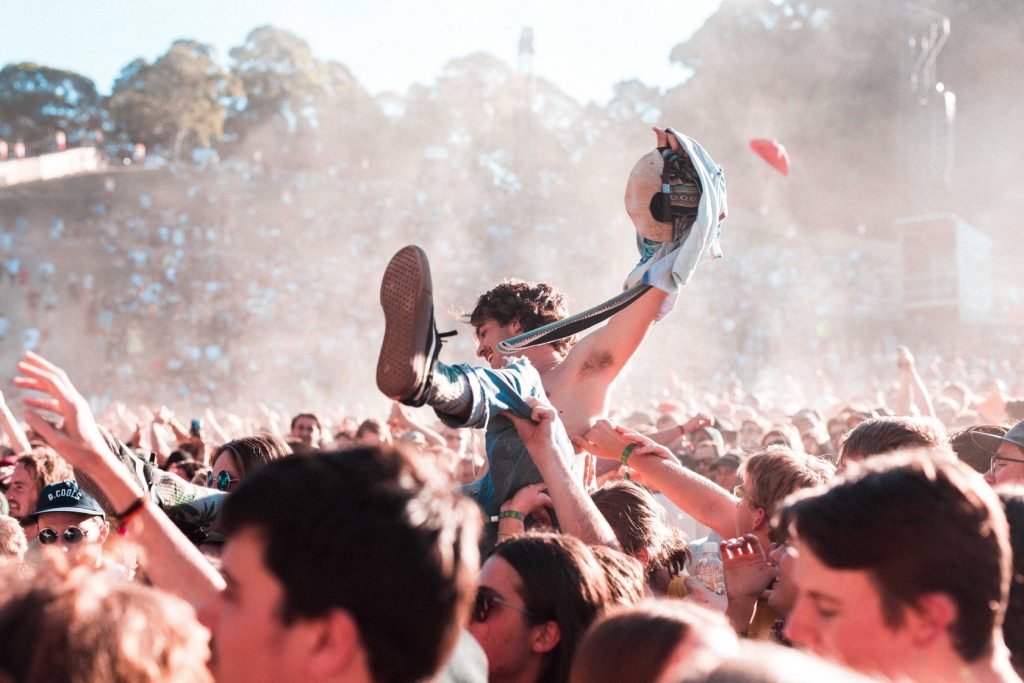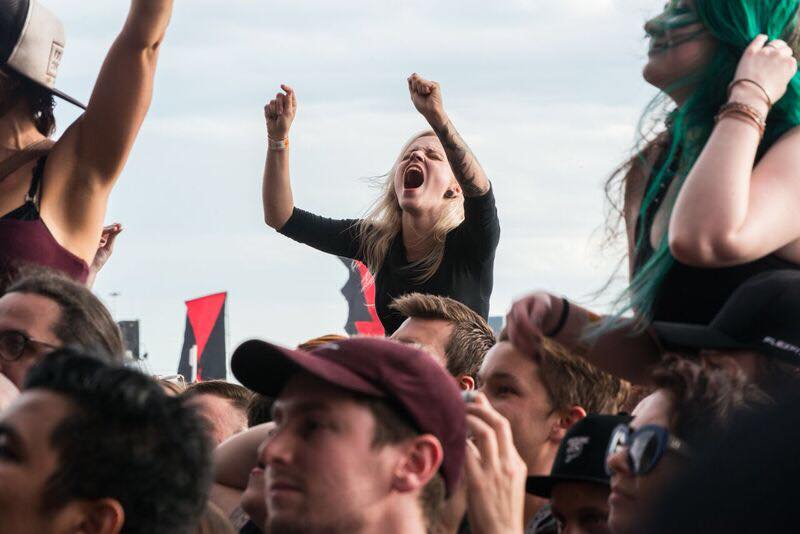Is Australia About To Enter A New Mega Festival Golden Age?
After crumbling a few years ago, Australia's touring festivals are coming back bigger than ever.

It’s been a big couple of weeks in the Australian festival scene.
Just under two weeks ago, the freshly minted Good Things Festival unveiled a massive line-up for its debut event later this year, with acts such as The Offspring, Stone Sour, Bullet For My Valentine, All Time Low, BABYMETAL, and The Used locked in to appear.
They also revealed the festival wasn’t going to be a standalone event: instead, Good Things will be making its way up the east coast with stops scheduled in Melbourne, Sydney, and Brisbane. The announcement was gratefully received by rock and heavy fans — after all, there hasn’t been a touring heavy festival since Soundwave packed it in at the end of 2015.
The following day, dance fans had their turn to rejoice: Hardware and Onelove — the companies behind the beloved and now-defunct Stereosonic — announced they would be joining forces again for another gargantuan touring festival, focusing on dance, hip-hop, and pop. Called Festival X, it will also be hosting three events on the East Coast, just a month before Good Things.
And after Festival X and Good Things wrap up, February will see the debut of Ultra Australia (which will bring its full-blown EDM production to Sydney and Melbourne) while March will be home to the newly expanded heavy festival Download, which has events locked down in the same cities.
So in the coming six months, Australia will see the launch of three new mega festival brands, as well as the major expansion of a fourth. It’s the kind of schedule that hasn’t been seen since the summers of 2014 and 2015, when festivals like Stereosonic, Future Music, Soundwave, and Big Day Out dominated the festival landscape.
By the looks of it, we’re about to enter a new golden age of Australian festivals…so how did we get here?
The Sad And Swift Decline
In the space of 18 months, Australia’s mega festival scene collapsed. Big Day Out was the first to buckle in mid-2014 — following a disastrous 2014 edition in which headliners Blur pulled out eight weeks before the event, and the second scheduled Sydney BDO show was cancelled due to poor ticket sales. It was no great surprise when C3, BDO’s US-based parent company, announced the festival wouldn’t be going ahead in 2015.
The next festival to go was Future Music, which called it quits after its mammoth 2015 event featuring Avicii, Drake, and The Prodigy. Organisers didn’t mince words when announcing the end of the festival: “It’s been a difficult decision to make,” they wrote. “But in the end travelling the festival in its current form across Australia simply doesn’t make financial sense anymore.”
Soundwave crumbled a few months later following a significant decline in ticket sales — between their 2013 and 2014 events, ticket revenue reportedly fell by a staggering $23 million.
Lastly, it was Stereosonic’s turn. In early 2016 its parent company SFX filed for bankruptcy in the US — and despite early reassurances from Australian promoters Totem OneLove Group that this wouldn’t affect the festival, the 2016 event was officially called off.

Smaller Festivals Have Been Dominating The Game
The loss of Australia’s four mega festivals was devastating, but it also allowed smaller, boutique events to get their foot in door. Festivals like Secret Garden, Let Them Eat Cake, Groovin’ The Moo, Days Like This, Pitch, Electric Gardens, Beyond The Valley, and FOMO have now become much-loved regulars of the festival calendar.
“People really enjoy going to an event in their city, curated for them by people that live in that city, that love the same music,” Jess Krishnaswamy, co-founder of BBE and FOMO Festival, tells Music Junkee. “All these smaller festivals are grown and born out of really smart, cool people — or teams of people — that really know what they love, and they just want to put on an event that they would personally go to.
“The one-size-fits-all approach [of big festivals] became more difficult, because there were these low-key, smart teams of people putting on cool events that were bespoke. What the kids like in Melbourne is different to what the kids like in Brisbane, and different to what the kids like in Perth — having that kind of bespoke approach cuts through.”
Krishnaswamy points to Melbourne’s Let Them Eat Cake as a prime example of a bespoke, one-city event — curated and conceived by Melbourne music lovers for a Melbourne music loving audience. She also highlights Victoria’s Pitch Music Festival and Sydney’s Days Like This, two events that share almost identical line-ups but are marketed and set-up completely differently. Pitch is a three-day camping festival, whereas Days Like This takes over Sydney’s Victoria Park for one day only.
“They have been tailored by the people that are putting them on for the audience they are promoting it to, so they are different,” she says. “The creative is different. The roll out is different. The communication points are different. The people that are talking about it are different. They’re basically identical lineups, but just presented in the right way for the right audience.”
Apart from the boutique events, destination-driven festivals like Splendour in the Grass, Falls Festival, Beyond The Valley, and Lost Paradise continue to sell out each year — another indication that audiences are more than willing to shill out when there’s more on offer than just music.

Splendour in the Grass 2017. Photo credit: Jack Toohey/inthemix
The Return Of The Mega Festival
So what’s changed in the years since the collapse of Stereosonic and Soundwave? Why are we now seeing a new explosion of mega festivals?
Well, there are a few things at play. The first, and most obvious, is that the fall of the previous mega festivals opened up a significant gap in the market for promoters looking to enter the space. Heavy music fans were crying out for a replacement for Soundwave, and Good Things and Download are more than happy to come in and fill the void. It’s the same situation with dance fans and the loss of Stereosonic and the rise of Ultra and Festival X.
The second thing to consider is that two of these new mega festivals — Ultra Australia and Download — aren’t Australian owned. They are well-established overseas brands, with plenty of money in the bank and plenty of crew and artist connections to call upon. Ultra has been rapidly expanding across the globe since it launched in Miami in 1999 (it now hosts events in dozens of countries every year) while the originally British Download runs festivals in France, Spain, and now Australia.
The fall of the previous mega festivals opened up a significant gap in the market for promoters looking to enter the space.
Festival X, while it’s being spearhead by Australian promoters Frank Cotela and Richie McNeill (of Onelove and Hardware, respectively), also has the backing of global touring behemoth Live Nation, which is based in LA. Live Nation have been making significant inroads into the Australian festival industry over the last two years, including purchasing a majority stake in Splendour and Falls promoters Secret Sounds in December 2016.
“It’s been a couple of years, and people are learning,” says Krishnaswamy. “The market has changed a lot and continues to change, and there are some good promoters out there that have really got a handle on what this new audience looks like and are wanting to give it another crack again or for the first time.”
“I think dance music coming back to the fore and people really being dedicated, promoting and trying to sell tickets for that genre again is a very good thing,” she adds “Because since losing all of those big dance festivals, the market hasn’t been the same.”
There’s another big reason for the festival explosion: the continuing downfall of city nightlife on the east coast.
“All these festivals coming back, and the proliferation of lots of different events and lots of things to choose from and busy summers, is because the government has ripped the guts out of our nightlife,” argues Krishnaswamy. “You can’t go to nightclubs. You can’t go to a club and pay $15 and see the next Alison Wonderland anymore, or the next Flume or the next Flight Facilities.
“Which is fucking heartbreaking — but in another way that has led to people realising that there’s other opportunities there for these type of events to exist. Because, generally, the scene at night is nonexistent in a few of those cities.”

Photo via Download Festival Australia Facebook
But Only The East Coast…
When Soundwave promoter AJ Maddah announced in 2014 that Perth wouldn’t be included on the festival’s next run around the country, he didn’t mince words as to why.
“Brisbane, Sydney, and Melbourne have been subsidising Perth since the thing went national,” he told a Ballarat radio station, adding that the cost of taking the production and crew across the country was “just crazy.” He said much the same of Big Day Out in a subsequent interview with triple j’s Hack.
“If you play it wrong, you can lose all the profit that you’ve made on the East Coast on one shitty show in one of those cities.”
It’s not a new revelation that touring in Perth and Adelaide is expensive. A large chunk of international artist tours won’t go there — let alone gigantic touring festivals with truckloads of production, artists, and their crew. So it’s hardly surprisingly the two cities were noticeably left off the schedule for Good Things, Festival X, Download, and Ultra Australia.
“Putting on a festival is fucking expensive,” explains Krishnaswamy. “It’s over a million dollars-worth of cost just to open the gates. Markets like Perth and Adelaide are risky — you’re trusting that you can sell more that a million dollars in ticket sales. That’s a huge risk. And I just think people don’t think they can sell the tickets. It’s honestly as simple as that.
“If you play it wrong, you can lose all the profit that you’ve made on the East Coast on one shitty show in one of those cities.”
It’s disappointing for audiences in Perth and Adelaide, but given the manner in which Future Music and Soundwave crumbled it’s understandable promoters are being extra cautious.
Will We Reach Festival Saturation?
With smaller festivals cropping up at a rate of knots, and mega festivals steadily moving back into the landscape, there is a very real danger that Australia could reach festival saturation point. With dozens of festivals vying for similar acts over the same period, it’s going to become a matter of who has the deepest pockets.
“We will very soon see a tipping point where some current great festivals that we all love over that New Years Eve, January/February period, will actually….well something has to give,” says Krishnaswamy. “Even just in New Zealand, over New Years Eve there’s six massive festivals all vying for the same acts, for the same time period. It’s tough.
“By this summer we will have reached total saturation point, and that’s when you see things fall off again, which is a shame because there’s a lot of great grassroots festivals that have built themselves up over the last few years — which this year have had the hardest time booking lineups than ever before, just purely for the fact that there is so much on over that time period. Booking the festivals for 2018/2019 summer has definitely been the hardest ever. Every single booker is going for the same acts.”
There’s only real one given in the Australian festival industry: everything changes, constantly.
“Nothing is a given these days with any festival,” Krishnaswamy says. “Being able to have a big and beautiful, successful, well curated, safe touring festival for 10 years plus, that’s a real skill.”
—
Jules LeFevre is Junkee’s Music Writer. Follow her on Twitter.



